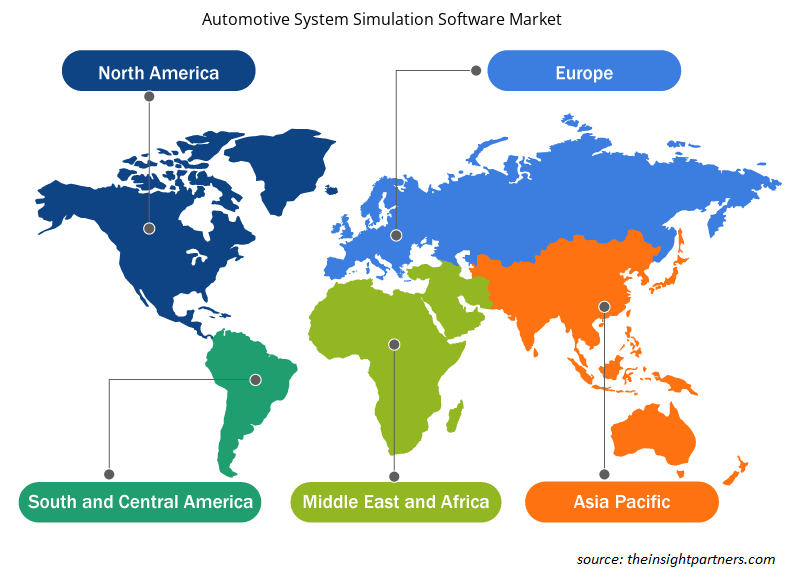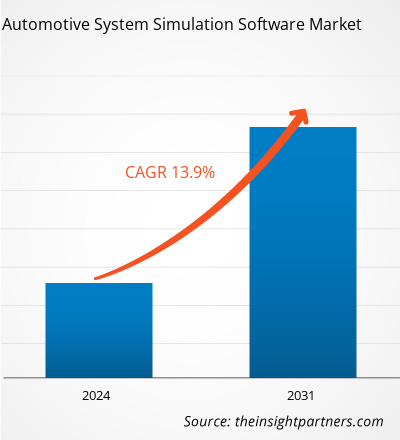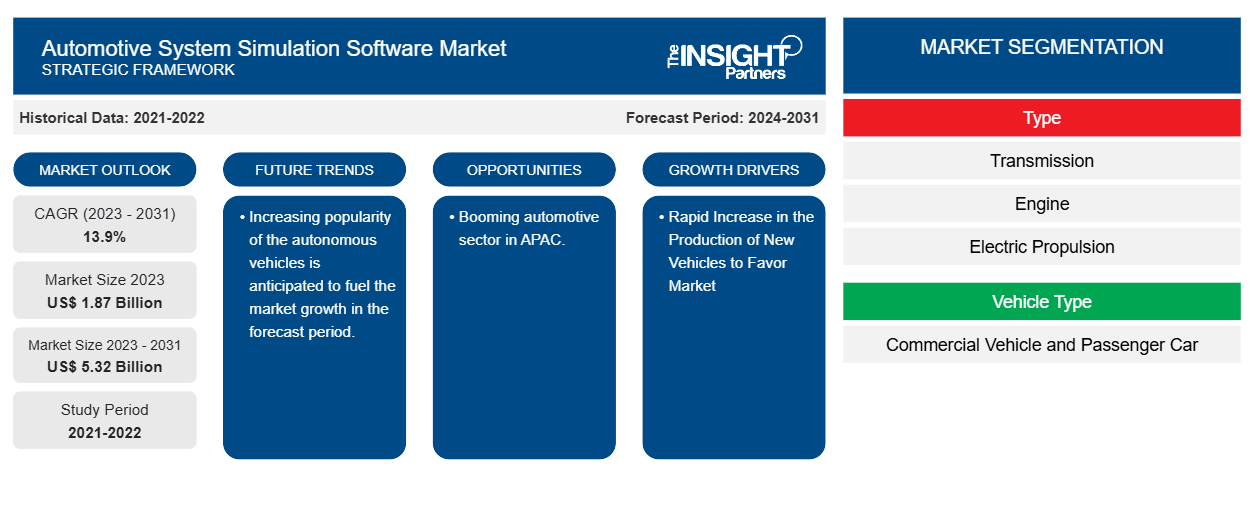自動車システムシミュレーションソフトウェアの市場規模は、2023年の18億7,000万米ドルから2031年には53億2,000万米ドルに達すると予測されています。市場は2023年から2031年の間に13.9%のCAGRを記録すると予想されています。車両機能のアップグレードとE/Eコンポーネント数の増加、電気自動車の生産と販売の増加は、市場の主要なトレンドと推進要因であり続けると思われます。
自動車システムシミュレーションソフトウェア市場分析
自動車システム シミュレーション ソフトウェア市場の需要は、新車生産の急増に伴い増加すると予想されています。OEM は、従来のプロトタイピング手法を自動車システム シミュレーションに移行して、新しいモデルを開発し、既存のモデルを改良しており、これが自動車システム シミュレーション ソフトウェア市場の活性化につながっています。
自動車システムシミュレーションソフトウェア市場の概要
自動車システム シミュレーション ソフトウェア (ASM) は、必要に応じて統合できる自動車アプリケーション用のシミュレーション モデルで構成されるツール スイートです。モデルは、燃焼エンジンや電気モーターなどの個々のコンポーネントから、車両ダイナミクス システム、複雑な仮想交通シナリオまで、幅広いシミュレーションをサポートします。モデルは、グラフィカル ユーザー インターフェイスの ModelDesk を使用して、簡単かつ直感的に操作できます。
要件に合わせてレポートをカスタマイズする
このレポートの一部、国レベルの分析、Excelデータパックなど、あらゆるレポートを無料でカスタマイズできます。また、スタートアップや大学向けのお得なオファーや割引もご利用いただけます。
-
このレポートの主要な市場動向を入手してください。この無料サンプルには、市場動向から見積もりや予測に至るまでのデータ分析が含まれます。
自動車システムシミュレーションソフトウェア市場の推進要因と機会
新車生産の急増が市場を有利に
新車生産の急増が、自動車システムシミュレーションソフトウェア市場の成長を牽引しています。新車生産が増加するにつれて、自動車システムシミュレーションソフトウェアの需要も増加しています。たとえば、欧州自動車製造者協会(ACEA)によると、2022年には世界中で8,540万台の自動車が生産され、2021年と比較して5.7%増加しました。したがって、新車生産の増加は、自動車システムシミュレーションソフトウェア市場の成長を牽引する可能性があります。
アジア太平洋地域で急成長する自動車部門。
アジア太平洋地域の自動車産業はここ数年で活況を呈しています。急速な都市化、経済の繁栄、人口増加によって成長が促進され、アジア諸国では人や物資の移動ニーズが高まっています。さらに、自動車は時とともに近代化が進んでいます。さらに、この地域の KIA、Nio などの多くの企業が製品開発に注力しています。
自動車システムシミュレーションソフトウェア市場レポートセグメンテーション分析
自動車システムシミュレーションソフトウェア市場分析の導出に貢献した主要なセグメントは、タイプ、車両タイプ、および推進タイプです。
- 自動車システムシミュレーションソフトウェア市場は、タイプ別にトランスミッション、エンジン、電気推進、燃料電池、ドライブライン、シャーシ、その他に分類されます。トランスミッションセグメントは、予測期間中に最大のシェアを占めると予想されます。
- 車両タイプに基づいて、自動車システムシミュレーションソフトウェア市場は商用車と乗用車に分かれています。予測期間中、商用車セグメントが最大のシェアを占めると予想されます。
- 推進タイプに基づいて、自動車システムシミュレーションソフトウェア市場はICEと電気に分かれています。ICEセグメントは予測期間中に最大のシェアを占めると予想されます。
自動車システムシミュレーションソフトウェアの地域別市場シェア分析
自動車システムシミュレーションソフトウェア市場レポートの地理的範囲は、主に北米、アジア太平洋、ヨーロッパ、中東およびアフリカ、南米および中米の 5 つの地域に分かれています。
APAC が市場を支配しています。この地域には、現代の技術進歩に重点を置くメーカーが数多くあります。また、この地域は中国、日本、インドなどの新興経済国で構成されています。これらの国には重要な自動車産業があります。さらに、都市化と工業化により、大量の車両生産の需要が増加しており、それがこの地域の自動車システム シミュレーション ソフトウェア市場を活性化させています。
自動車システムシミュレーションソフトウェア市場の地域別分析
予測期間を通じて自動車システム シミュレーション ソフトウェア市場に影響を与える地域的な傾向と要因は、Insight Partners のアナリストによって徹底的に説明されています。このセクションでは、北米、ヨーロッパ、アジア太平洋、中東およびアフリカ、南米および中米にわたる自動車システム シミュレーション ソフトウェア市場のセグメントと地理についても説明します。

- 自動車システムシミュレーションソフトウェア市場の地域別データを入手
自動車システムシミュレーションソフトウェア市場レポートの範囲
| レポート属性 | 詳細 |
|---|---|
| 2023年の市場規模 | 18億7千万米ドル |
| 2031年までの市場規模 | 53.2億米ドル |
| 世界のCAGR(2023年~2031年) | 13.9% |
| 履歴データ | 2021-2022 |
| 予測期間 | 2024-2031 |
| 対象セグメント |
タイプ別
|
| 対象地域と国 |
北米
|
| 市場リーダーと主要企業プロフィール |
|
自動車システムシミュレーションソフトウェア市場のプレーヤー密度:ビジネスダイナミクスへの影響を理解する
自動車システム シミュレーション ソフトウェア市場は、消費者の嗜好の変化、技術の進歩、製品の利点に対する認識の高まりなどの要因により、エンド ユーザーの需要が高まり、急速に成長しています。需要が高まるにつれて、企業は提供内容を拡大し、消費者のニーズを満たすために革新し、新たなトレンドを活用し、市場の成長をさらに促進しています。
市場プレーヤー密度とは、特定の市場または業界内で活動している企業または会社の分布を指します。これは、特定の市場スペースに、その市場規模または総市場価値に対してどれだけの競合相手 (市場プレーヤー) が存在するかを示します。
自動車システムシミュレーションソフトウェア市場で事業を展開している主要企業は次のとおりです。
- ESIグループ
- ANSYS, Inc
- ヘキサゴンAB
- dSPACE株式会社
- シーメンス
- モデロン
免責事項:上記の企業は、特定の順序でランク付けされていません。

- 自動車システムシミュレーションソフトウェア市場のトップキープレーヤーの概要を入手
自動車システムシミュレーションソフトウェア市場のニュースと最近の動向
自動車システム シミュレーション ソフトウェア市場は、主要な企業出版物、協会データ、データベースなどの一次調査と二次調査後の定性的および定量的データを収集することによって評価されます。自動車システム シミュレーション ソフトウェア市場におけるいくつかの開発を以下に示します。
- 計算知能の世界的リーダーである Altair は、航空宇宙および防衛分野で大きな実績を持ち、海洋、エネルギー、ターボ機械、自動車アプリケーションでも存在感を高めている計算流体力学 (CFD) ソフトウェアを提供する FlightStream のメーカーである Research in Flight を買収したことを発表しました。FlightStream は、高忠実度の CFD シミュレーションとエンジニアや設計者のニーズとの間のギャップを埋める、ユーザーフレンドリーでありながら強力なフロー ソルバーです。(出典: Altair、企業 Web サイト、2024 年 5 月)
- ローデ・シュワルツは、仮想テストドライビングのパイオニアである IPG Automotive と提携し、自動車レーダーのハードウェア・イン・ザ・ループ (HIL) 統合テストを再定義し、自動運転 (AD) テストを試験場から開発ラボに移行することでコストを削減しました。IPG Automotive の CarMaker シミュレーションソフトウェアと R&S AREG800A レーダーオブジェクトシミュレーター、および R&S QAT100 アドバンストアンテナアレイを組み合わせることで、自動車メーカーは、Euro NCAP で定義されているような ADAS/AD シナリオを、制御された安全で時間効率が良く、コストを削減しながらシミュレートできるようになります。(出典: ローデ・シュワルツの会社ウェブサイト、2024 年 4 月)
自動車システムシミュレーションソフトウェア市場レポートの対象範囲と成果物
「自動車システムシミュレーションソフトウェア市場の規模と予測(2021〜2031年)」レポートでは、以下の分野をカバーする市場の詳細な分析を提供しています。
- 対象範囲に含まれるすべての主要市場セグメントについて、世界、地域、国レベルでの自動車システム シミュレーション ソフトウェア市場の規模と予測。
- 自動車システム シミュレーション ソフトウェア市場の動向、および推進要因、制約、主要な機会などの市場動向。
- 詳細なPEST/ポーターの5つの力とSWOT分析
- 主要な市場動向、世界および地域の枠組み、主要プレーヤー、規制、最近の市場動向を網羅した自動車システム シミュレーション ソフトウェア市場分析。
- 市場集中、ヒートマップ分析、主要プレーヤー、自動車システム シミュレーション ソフトウェア市場の最近の動向を網羅した業界の状況と競争分析。
- 詳細な企業プロフィール。
- 過去2年間の分析、基準年、CAGRによる予測(7年間)
- PEST分析とSWOT分析
- 市場規模価値/数量 - 世界、地域、国
- 業界と競争環境
- Excel データセット
最新レポート
関連レポート
お客様の声
購入理由
- 情報に基づいた意思決定
- 市場動向の理解
- 競合分析
- 顧客インサイト
- 市場予測
- リスク軽減
- 戦略計画
- 投資の正当性
- 新興市場の特定
- マーケティング戦略の強化
- 業務効率の向上
- 規制動向への対応























 無料サンプルを入手 - 自動車システムシミュレーションソフトウェア市場
無料サンプルを入手 - 自動車システムシミュレーションソフトウェア市場